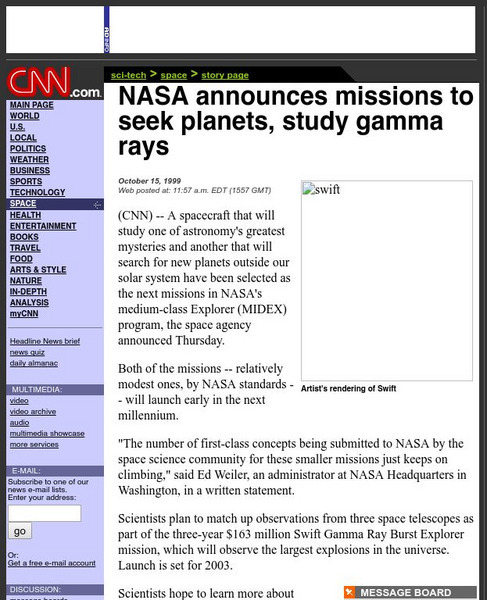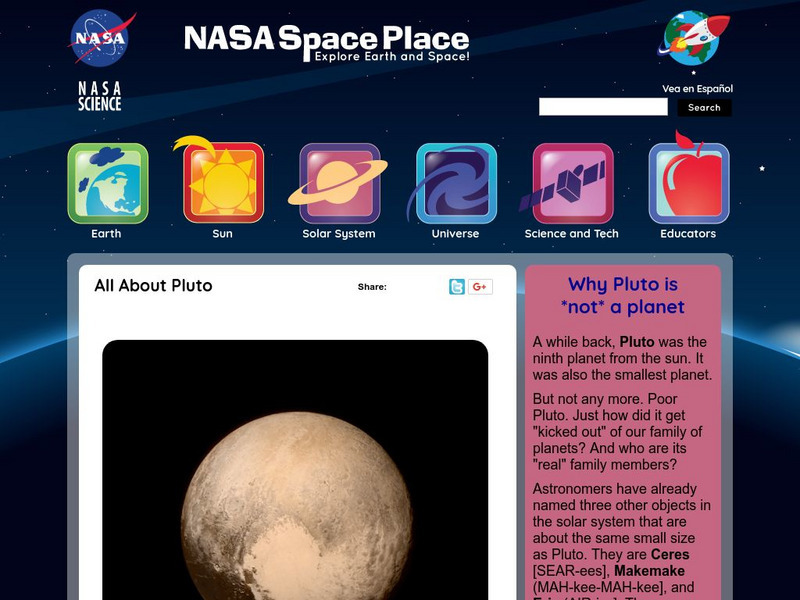NASA
Nasa Star Child: Where Oh Where Does That Little Object Go?
See if you can identify the positions of the 9 planets in our solar system. Take an online quiz and get feedback on your answers.
NASA
Nasa: Kepler's Third Law
This site from NASA states Kepler's third law of motion and extends it to develop an equation for the velocity of an orbiting planet.
NASA
Nasa: Kepler's Second Law
This site from NASA states Kepler's second law of planetary motion and depicts its meaning with an informative diagram. Relates the law to conservation of energy principles and discusses the eccentricity of a satellite's (or a planet's)...
NASA
Nasa Star Child: Planet Hop
Figure out your age and your weight on all the planets in the solar system using the formulas given here. Then type them into the correct place, and let the computer check to see if you are correct.
NASA
Nasa: What Is Stereo Vision?
The robots NASA sends to explore other planets need two good eyes, just like humans. Learn why through this simple exercise.
NASA
Nasa: Magellan Mission to Venus
This home page from NASA offers Venus images taken by Magellan and other highlights from the mission. In orbit around Venus for four years this mission provided maps of 98 percent of the surface of Venus that are more detailed than most...
NASA
Nasa: Astronomy Picture of the Day: Jupiter From Voyager
Taken by Voyager 1 as it passed Jupiter in 1979, this image shows the Great Red Spot, which is a hurricane-like storm that has lasted over 300 years, and is more than three times the size of planet Earth.
CNN
Cnn: Nasa Announces Missions to Seek Planets, Study Gamma Rays
A news article about NASA's plans to learn more about gamma rays and discover more planets launched in 1999.
NASA
Nasa Space Place: All About Earth
Brief description of the earth's structure, surface, neighbors, and history with images.
NASA
Nasa: Huge Springtime Storms Hit the Planet Uranus
Describes in detail the devastating storms that occur on Uranus.Also includes an .mpeg movie showing the rings of Uranus up close. (Mar. 29, 1999)
NASA
Nasa: Welcome to the Planets the Explorers
View photographs of space craft and read about their assembly, launching, and where they went.
BBC
Bbc Newsround: One in Five Suns Has Habitable World
Using the Kepler telescope, NASA scientists have estimated that one in five of suns in space host an Earth-like planet in what is called the habitable zone.
NASA
Nasa: Solar System Exploration: Phobos
General information about Mars' moon Phobos can be found on this site. An image is also provided.
NASA
Nasa: Space Place: Where Does Interstellar Space Begin?
Find out about interstellar space, and what characterizes this part of space outside of the heliosphere.
NASA
Nasa Space Place: What Is an Exoplanet?
Defines exoplanets and explains how astronomers go about looking for them.
NASA
Nasa Space Place: All About Mars
Learn all about Mars and the Mars Rovers, and see images of what it looks it.
NASA
Nasa: The Space Place: Hail King of the Ice Dwarfs
This resource provides a nice overview of Pluto. Get information on Pluto's size, tilt, orbit and surface features. There is also a brief explanation of the "New Horizons" space probe.
NASA
Nasa: Space Place: Solar System Switch a Roo
Play this creative puzzle game where the player views a solar system object that is all mixed-up. Try and find the matching parts of the photograph, and learn about the solar system in the process.
NASA
Nasa: Climate Kids: Planet Health Report: Air
Students see the amount of carbon in Earth's atmophere with this graph explained in basic terms.
NASA
Nasa's the Space Place: King of the Ice Dwarfs
An information page all about Pluto! Learn about Pluto's size, path around the sun, temperature, location, and traveling partner Charon.
NASA
Nasa Star Child: The Solar System
Discover information about parts of the Solar System, along with definitions just by clicking on highlighted vocabulary terms. Be sure to try the "Solar System Activities" to review the material from these pages.
NASA
Nasa Space Science Data Archive: Neptune Fact Sheet
Resource has text information to compare Neptune with Earth. Includes Neptune observational data, orbital data, magnetosphere, and atmosphere. Also contains an image of Neptune that can be enlarged.
NASA
Nasa Space Science Data Archive: Neptunian Rings Fact Sheet
A data table of nearly everything known about the ring system of Neptune. The resource also includes an image of the rings of Neptune that can be enlarged.
Space Telescope Science Institute
Space Telescope Science Institute: Hubble Space Telescope
Find out how astronomers are conducting extensive observations to estimate how many planets in our Milky Way galaxy might be potential abodes for life.




















